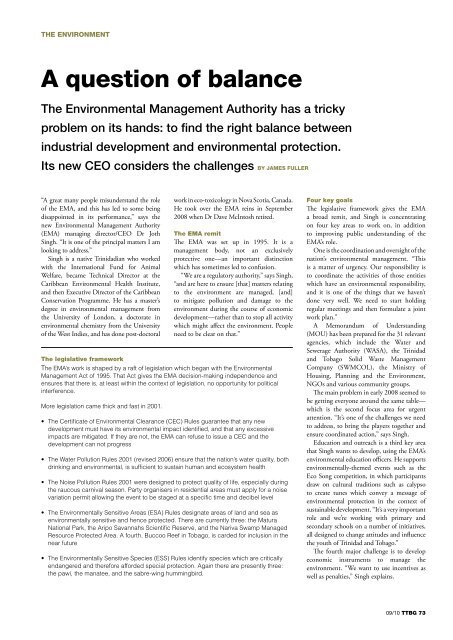The Trinidad & Tobago Business Guide (TTBG, 2009-10)
- No tags were found...
Create successful ePaper yourself
Turn your PDF publications into a flip-book with our unique Google optimized e-Paper software.
THE ENVIRONMENT<br />
A question of balance<br />
<strong>The</strong> Environmental Management Authority has a tricky<br />
problem on its hands: to find the right balance between<br />
industrial development and environmental protection.<br />
Its new CEO considers the challenges By James Fuller<br />
“A great many people misunderstand the role<br />
of the EMA, and this has led to some being<br />
disappointed in its performance,” says the<br />
new Environmental Management Authority<br />
(EMA) managing director/CEO Dr Joth<br />
Singh. “It is one of the principal matters I am<br />
looking to address.”<br />
Singh is a native <strong>Trinidad</strong>ian who worked<br />
with the International Fund for Animal<br />
Welfare, became Technical Director at the<br />
Caribbean Environmental Health Institute,<br />
and then Executive Director of the Caribbean<br />
Conservation Programme. He has a master’s<br />
degree in environmental management from<br />
the University of London, a doctorate in<br />
environmental chemistry from the University<br />
of the West Indies, and has done post-doctoral<br />
work in eco-toxicology in Nova Scotia, Canada.<br />
He took over the EMA reins in September<br />
2008 when Dr Dave McIntosh retired.<br />
<strong>The</strong> EMA remit<br />
<strong>The</strong> EMA was set up in 1995. It is a<br />
management body, not an exclusively<br />
protective one—an important distinction<br />
which has sometimes led to confusion.<br />
“We are a regulatory authority,” says Singh,<br />
“and are here to ensure [that] matters relating<br />
to the environment are managed, [and]<br />
to mitigate pollution and damage to the<br />
environment during the course of economic<br />
development—rather than to stop all activity<br />
which might affect the environment. People<br />
need to be clear on that.”<br />
<strong>The</strong> legislative framework<br />
<strong>The</strong> EMA’s work is shaped by a raft of legislation which began with the Environmental<br />
Management Act of 1995. That Act gives the EMA decision-making independence and<br />
ensures that there is, at least within the context of legislation, no opportunity for political<br />
interference.<br />
More legislation came thick and fast in 2001.<br />
• <strong>The</strong> Certificate of Environmental Clearance (CEC) Rules guarantee that any new<br />
development must have its environmental impact identified, and that any excessive<br />
impacts are mitigated. If they are not, the EMA can refuse to issue a CEC and the<br />
development can not progress<br />
• <strong>The</strong> Water Pollution Rules 2001 (revised 2006) ensure that the nation’s water quality, both<br />
drinking and environmental, is sufficient to sustain human and ecosystem health<br />
• <strong>The</strong> Noise Pollution Rules 2001 were designed to protect quality of life, especially during<br />
the raucous carnival season. Party organisers in residential areas must apply for a noise<br />
variation permit allowing the event to be staged at a specific time and decibel level<br />
• <strong>The</strong> Environmentally Sensitive Areas (ESA) Rules designate areas of land and sea as<br />
environmentally sensitive and hence protected. <strong>The</strong>re are currently three: the Matura<br />
National Park, the Aripo Savannahs Scientific Reserve, and the Nariva Swamp Managed<br />
Resource Protected Area. A fourth, Buccoo Reef in <strong>Tobago</strong>, is carded for inclusion in the<br />
near future<br />
• <strong>The</strong> Environmentally Sensitive Species (ESS) Rules identify species which are critically<br />
endangered and therefore afforded special protection. Again there are presently three:<br />
the pawi, the manatee, and the sabre-wing hummingbird.<br />
Four key goals<br />
<strong>The</strong> legislative framework gives the EMA<br />
a broad remit, and Singh is concentrating<br />
on four key areas to work on, in addition<br />
to improving public understanding of the<br />
EMA’s role.<br />
One is the coordination and oversight of the<br />
nation’s environmental management. “This<br />
is a matter of urgency. Our responsibility is<br />
to coordinate the activities of those entities<br />
which have an environmental responsibility,<br />
and it is one of the things that we haven’t<br />
done very well. We need to start holding<br />
regular meetings and then formulate a joint<br />
work plan.”<br />
A Memorandum of Understanding<br />
(MOU) has been prepared for the 31 relevant<br />
agencies, which include the Water and<br />
Sewerage Authority (WASA), the <strong>Trinidad</strong><br />
and <strong>Tobago</strong> Solid Waste Management<br />
Company (SWMCOL), the Ministry of<br />
Housing, Planning and the Environment,<br />
NGOs and various community groups.<br />
<strong>The</strong> main problem in early 2008 seemed to<br />
be getting everyone around the same table—<br />
which is the second focus area for urgent<br />
attention. “It’s one of the challenges we need<br />
to address, to bring the players together and<br />
ensure coordinated action,” says Singh.<br />
Education and outreach is a third key area<br />
that Singh wants to develop, using the EMA’s<br />
environmental education officers. He supports<br />
environmentally-themed events such as the<br />
Eco Song competition, in which participants<br />
draw on cultural traditions such as calypso<br />
to create tunes which convey a message of<br />
environmental protection in the context of<br />
sustainable development. “It’s a very important<br />
role and we’re working with primary and<br />
secondary schools on a number of initiatives,<br />
all designed to change attitudes and influence<br />
the youth of <strong>Trinidad</strong> and <strong>Tobago</strong>.”<br />
<strong>The</strong> fourth major challenge is to develop<br />
economic instruments to manage the<br />
environment. “We want to use incentives as<br />
well as penalties,” Singh explains.<br />
09/<strong>10</strong> <strong>TTBG</strong> 73


















